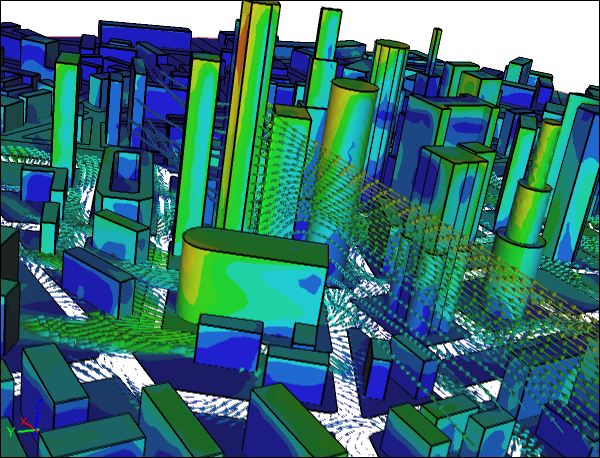
Failure to Simulate
Given the availability of Computer Aided Engineering (CAE) analysis tools, such as Computational Fluid Dynamics (CFD), it is a surprise that analysis tools are not used more by architects during building concept design, especially relative to the local environment around a building.
 CFD Simulation of SkyscrapersAir Velocity Vectors
CFD Simulation of SkyscrapersAir Velocity Vectors
I say this because it is not evident that environmental analyses were performed on London's latest skyscraper, nicknamed the 'Walkie-Talkie', otherwise there wouldn't be cars melting due to the focused sun rays reflected off the concave all-glass exterior.
Neither is there evidence that for Yorkshire's tallest building, Bridgewater Place, designers performed an analysis of the air flow around the building. There's a good chance that such an analysis would have predicted the concentrated localized winds around the building and forced a design change that would have avoided a number of injuries and one tragic death.
I doubt it is a lack of funds preventing environment analysis given the huge cost of skyscraper construction. Maybe it falls to planners to hold architects to a clause, such as 'do no harm' to the surrounding environment and inhabitants, with specific mention to consider localized wind speeds and ground level temperatures due to sun reflection.
The options to mitigate the impact of a building on the surrounding environment are severely limited and extremely costly once a building is complete. Clearly this is a scenario where expanded concept design analysis is a must.
Recent blog posts
- CFD Simulates Distant Past
- Background on the Caedium v6.0 Release
- Long-Necked Dinosaurs Succumb To CFD
- CFD Provides Insight Into Mystery Fossils
- Wind Turbine Design According to Insects
- Runners Discover Drafting
- Wind Tunnel and CFD Reveal Best Cycling Tuck
- Active Aerodynamics on the Lamborghini Huracán Performante
- Fluidic Logic
- Stonehenge Vortex Revealed as April Fools' Day Distortion Field

Comments
CFD for Urban Planning
I'm going to guess that one reason CFD isn't used more by architects and urban planners is that they have unrealistic expectations of cost versus results. In other words, they really don't know what they can get from CFD, they don't appreciate what it would take to perform a sufficiently accurate computation, and how much the overall effort would cost.
On the other hand, the people who understand this and are using CFD in urban environments are folks involved in emergency preparedness. They need to know things like if someone release so much of substance X at a certain location, what will be its concentrations at various locations over time.
Great article
Having worked in the Australian building industry for about 5 years, your blog entry resonate well with my experience.
The building industry is a very interesting market which involved a large number of entities, typically developer, building owner, tenants, architect, design team, local council, certifiers, as well as various legal and voluntary schemes, some of which have competing interests and timeframe.
While it is true that CFD analysis can (should?) be used for a number of project, its application depends on two factors: Is it required by local code? Does the design team have the knowledge and willingness to put a value-added proposition associated with CFD?